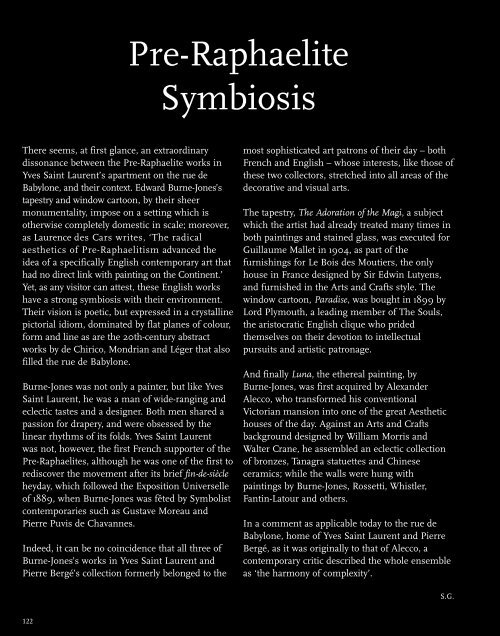Yves Saint Laurent Pierre Bergé - Christie's
Yves Saint Laurent Pierre Bergé - Christie's
Yves Saint Laurent Pierre Bergé - Christie's
Create successful ePaper yourself
Turn your PDF publications into a flip-book with our unique Google optimized e-Paper software.
122<br />
Pre-Raphaelite<br />
There seems, at first glance, an extraordinary<br />
dissonance between the Pre-Raphaelite works in<br />
<strong>Yves</strong> <strong>Saint</strong> <strong>Laurent</strong>’s apartment on the rue de<br />
Babylone, and their context. Edward Burne-Jones’s<br />
tapestry and window cartoon, by their sheer<br />
monumentality, impose on a setting which is<br />
otherwise completely domestic in scale; moreover,<br />
as Laurence des Cars writes, ‘The radical<br />
aesthetics of Pre-Raphaelitism advanced the<br />
idea of a specifically English contemporary art that<br />
had no direct link with painting on the Continent.’<br />
Yet, as any visitor can attest, these English works<br />
have a strong symbiosis with their environment.<br />
Their vision is poetic, but expressed in a crystalline<br />
pictorial idiom, dominated by flat planes of colour,<br />
form and line as are the 20th-century abstract<br />
works by de Chirico, Mondrian and Léger that also<br />
filled the rue de Babylone.<br />
Burne-Jones was not only a painter, but like <strong>Yves</strong><br />
<strong>Saint</strong> <strong>Laurent</strong>, he was a man of wide-ranging and<br />
eclectic tastes and a designer. Both men shared a<br />
passion for drapery, and were obsessed by the<br />
linear rhythms of its folds. <strong>Yves</strong> <strong>Saint</strong> <strong>Laurent</strong><br />
was not, however, the first French supporter of the<br />
Pre-Raphaelites, although he was one of the first to<br />
rediscover the movement after its brief fin-de-siècle<br />
heyday, which followed the Exposition Universelle<br />
of 1889, when Burne-Jones was fêted by Symbolist<br />
contemporaries such as Gustave Moreau and<br />
<strong>Pierre</strong> Puvis de Chavannes.<br />
Indeed, it can be no coincidence that all three of<br />
Burne-Jones’s works in <strong>Yves</strong> <strong>Saint</strong> <strong>Laurent</strong> and<br />
<strong>Pierre</strong> <strong>Bergé</strong>’s collection formerly belonged to the<br />
Symbiosis<br />
most sophisticated art patrons of their day – both<br />
French and English – whose interests, like those of<br />
these two collectors, stretched into all areas of the<br />
decorative and visual arts.<br />
The tapestry, The Adoration of the Magi, a subject<br />
which the artist had already treated many times in<br />
both paintings and stained glass, was executed for<br />
Guillaume Mallet in 1904, as part of the<br />
furnishings for Le Bois des Moutiers, the only<br />
house in France designed by Sir Edwin Lutyens,<br />
and furnished in the Arts and Crafts style. The<br />
window cartoon, Paradise, was bought in 1899 by<br />
Lord Plymouth, a leading member of The Souls,<br />
the aristocratic English clique who prided<br />
themselves on their devotion to intellectual<br />
pursuits and artistic patronage.<br />
And finally Luna, the ethereal painting, by<br />
Burne-Jones, was first acquired by Alexander<br />
Alecco, who transformed his conventional<br />
Victorian mansion into one of the great Aesthetic<br />
houses of the day. Against an Arts and Crafts<br />
background designed by William Morris and<br />
Walter Crane, he assembled an eclectic collection<br />
of bronzes, Tanagra statuettes and Chinese<br />
ceramics; while the walls were hung with<br />
paintings by Burne-Jones, Rossetti, Whistler,<br />
Fantin-Latour and others.<br />
In a comment as applicable today to the rue de<br />
Babylone, home of <strong>Yves</strong> <strong>Saint</strong> <strong>Laurent</strong> and <strong>Pierre</strong><br />
<strong>Bergé</strong>, as it was originally to that of Alecco, a<br />
contemporary critic described the whole ensemble<br />
as ‘the harmony of complexity’.<br />
S.G.

















